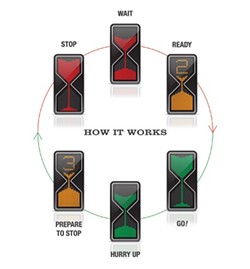Friday, November 19, 2010
Innovative Stoplight Design Is Ideal for SLC
Posted By Brandon Burt on November 19, 2010, 9:02 PM
Salt Lake City's traffic semaphores are often the target of much grumbling and criticism -- a common gripe being that lights are never synchronized well enough. ---
In a perfect world, drivers could breeze through every light between Point A and Point B without stopping even once. But, alas, the world is flawed, and sometimes we are required to stop at an intersection so that pedestrians may cross and traffic may flow perpendicularly to our desired vector of travel. Having to wait too long, or stop too many times during a trip, is enough to make any impatient motorist see red.
The city's transportation division has pointed out many times that "it is mathematically impossible for all of Salt Lake City's traffic lights to be 'synchronized' so that you will never hit red lights while driving around the city." Now, I haven't seen the math, but I'm willing to take the division's word for it -- given the complexity of Salt Lake's traffic-control system and the number of variables involved, it's undoubtedly an intractable problem*.
Still, an appeal to the driving public's algebraic sensibilities will never be very effective, no matter how many matrices and tensors are thrown in as evidence. Mathematics can be beautiful and elegant, but just try telling most people that -- once the subject comes up, they find themselves hearkening back to Mr. Patterson's 7th-grade unit on the Quadratic Formula, and how traumatic it was to remember the plus-or-minus-square-root-of-whatever-the-hell-it-is part. If elementary algebra is problematic, then higher maths is out of the question -- so the second-order problem of convincing people that there is no red-light conspiracy afoot, nor are the city engineers simply lazy and unimaginative, becomes just as intractable as the first.
The good news is this: Designer Thanva Tivawong has a new traffic light -- it won't eliminate red lights, but could make red lights more bearable for impatient motorists, and might even enhance safety at intersections.
The principles involved are less mathematical than philosophical: Terrible things happen to good people every day -- yes, even red lights. Sometimes the only thing that can make these hardships bearable is the reassurance that this, too, shall pass. Tivawong's design provides just this reassurance.
The "Sand Glass" stoplight replaces the traditional stacked three-circle traffic light with an LED display depicting the widely familiar "please wait" hourglass icon. As the bottom of the hourglass indicator fills up, the driver has a sense of how much time remains before the light changes.
Not only does this provide cheap, non-distracting entertainment for stopped motorists, it helps them prepare for action -- rather than drifting off into one of those red-light daydreams that can be broken only by a honk from behind, the driver can monitor his or her stoplight progress, much like waiting for an Internet download to complete.
What makes the Sand Glass traffic signal ideal for us?
Since its inception, Salt Lake City's street system has been known for ingenuity. Our grid-based layout -- famously implemented by Brigham Young -- makes it difficult to get lost anywhere in the city, and Young's early edict that streets be constructed wide enough to make oxcart U-turns possible was nothing less than visionary. Today, there aren't many oxcarts around, but we have plenty of room for TRAX tracks, middle-of-the-street parking, bike lanes, and all kinds of infrastructure improvements that would have been nearly impossible on traditionally skinny streets.
Our city was among the first to install the countdown pedestrian signals, as well as the ones that emit audible chirps -- both of which help people cross the street without getting killed. Commuterlink ties together city, county and state agencies to allow for a more efficient, integrated traffic-control approach than has ever been possible before (although some find this whole government-spy-camera craze to be weirdly Orwellian). Even the low-tech orange-flags-for-pedestrians and "Adopt-a-Crosswalk" programs seemed weird at first, but today there's little doubt that they have reduced the incidence of human-vs.-automobile casualties.
Say what you will, Salt Lake City has long been on the cutting edge of urban transportation control. Our logical, Cartesian street system eliminates many variables that complicate traffic-control engineering in most other cities. That's what makes us a perfect venue to test out Tivawong's new design.
By the way -- nobody ever extols the virtues of the Salt Lake City Division of Transportation. The only time the subject comes up is when there's something to complain about, which I imagine is very disheartening for them. So, I'd like to go on the record as saying, "Buck up, transportation engineers! You're doing a fantastic job!"
Next time you're sitting through three lights during rush hour going west on 400 South at Main, or trying to make a left turn onto 1300 East from 500 South during one of those complicated and interminable traffic cycles, think of all those variables and vectors and tensors and matrices -- and just be grateful: It's not your job to do the math.
* Still, I'm curious whether "mathematically impossible" means a rigorous proof exists that there positively is no conceivable way to sync the city's lights perfectly, or if it just means the problem is so complex that an ideal solution cannot be computed within a reasonable amount of time.
|
Brandon's Big Gay Blog |
On Topic...
-
Film Reviews: New Releases for April 19
The Ministry of Ungentlemanly Warfare, Abigail, The Beast, Hard Miles, Sasquatch Sunset and more
- Apr 19, 2024
-
Film Reviews: New Releases for April 12
Civil War, Escape from Germany, Coup de Chance, Hundreds of Beavers, La Chimera, Sting
- Apr 11, 2024
-
Film Reviews: New Releases for April 5
Monkey Man, The First Omen, Wicked Little Letters, Girls State, Scoop, Exhuma
- Apr 4, 2024
- More Brandon's Big Gay Blog » More Culture »
More by Brandon Burt
-
Utah Republican Has Moment of Sanity
Utah GOP's MLK Day Press Release Uncharacteristically Devoid of Deranged Commentary; Concerned Constituents Puzzled
- Jan 18, 2016
-
MLK Day 2016 Celebration Rally & Marade
- Jan 18, 2016
-
This holiday has been brought to you by the letter 'X'
Xmas, Christmas and exotic alphabets
- Dec 23, 2015
- More »





